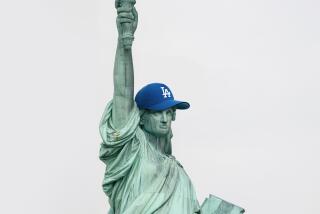Once in Fashion, the Brown Derby Became Old Hat
In its 50-year heyday, the Brown Derby was where Hollywood hung its hat. The all-night eatery was as sublime as the top-grade, top-dollar caviar it spooned out, and as proudly low-brow as its buck-a-burger.
The first of four Brown Derbys opened on Wilshire Boulevard in 1926, across from the Ambassador Hotel. It was the only Derby shaped like a hat. During the 1920s, â30s and â40s, more Derbys opened, all serving as clubs for the Hollywood elite.
Legends revolved around Derby spots where Spencer Tracy, Ralph Bellamy and Pat OâBrien tippled into the wee hours.
The Derby was where Clark Gable proposed to Carole Lombard. Lucille Ball and Jack Benny lunched on Cobb salads, invented on the premises and named for the owner, Robert Cobb.
Cobb catered to the strange tastes of celebrity clients, concocting a grapefruit cake for dieting gossip columnist Louella Parsons and crafting a wedding cake of shortbread and caviar for Harpo Marx.
The second Brown Derby opened at Hollywood and Vine on Valentineâs Day in 1929, drawing stars whose caricatures would line the walls.
Two years later, the third Brown Derby opened at Wilshire Boulevard and Rodeo Drive in Beverly Hills. The fourth and last opened in Los Feliz in 1941.
The fourth Brown Derby is the last to remain standing, but it too is slated for the wrecking ball unless preservationists can save it. Its Brown Derby days ended around 1960; it has more recently operated as a nightclub and restaurant.
Its domed roof and lamella ceiling survived various remodelings. The ornate, oval bar, though not original to the building, was immortalized in the 1945 film âMildred Pierce,â in which Oscar-winning actress Joan Crawford recited the line: âWhy should people come to eat and go someplace else to drink?â This Derby also portrayed the exterior of Arnoldâs Drive-In for the 1970s television series âHappy Days.â
It opened in a building rented from director-producer Cecil B. DeMille, who had built it as a theater. When talkies came in, the theater became obsolete before it ever opened.
The Brown Derby undertaking began with a dare. Wisecracking screenwriter Wilson Mizner said to movie producer Herbert Somborn, who was Gloria Swansonâs second husband: âIf you know anything about food, you can sell it out of a hat.â
Shortly thereafter, in 1926, Somborn, Mizner and theater owner Sid Grauman built the first Brown Derby and called it the Little Hat. But Mizner said it was big enough to accommodate the swelled heads of many a personality. Early patrons included Will Rogers, Mary Pickford and Rudolph Valentino.
A decade later, the Derby moved half a block away into the hat-shaped building, topped by its neon-lighted slogan, âEat in the hat.â Derby-shaped light fixtures hovered over round tables and booths, attracting the likes of Charlie Chaplin, Jean Harlow and John and Lionel Barrymore.
Somborn met 26-year-old Robert Cobb at the Alexandria Hotel downtown, when both were competing for the same girl. Cobb was a cowboy from Montana who flipped burgers at a stand on Wilshire near La Brea.
Impressed with Cobbâs knowledge of the restaurant business, Somborn hired him to manage the new Derby. Cobb also worked as headwaiter, purchasing agent, banker, assistant chef, bouncer, dishwasher and bookkeeper. He invented the Cobb salad while rummaging through the refrigerator to feed some pals.
The Hollywood Derbyâs proximity to the studios often made it the scene of celebrity spats. Within its wood-paneled interior, press agents congregated for a word with the stars. Gossip columnists Hedda Hopper and Louella Parsons held court during lunch hour at separate tables on opposite sides of the room.
Marlene Dietrich caused an uproar in 1933 by walking in wearing slacks. She was even more shocked than her audience when Cobb refused to seat her. The comic duo of Bert Wheeler and Robert Woolsey, who witnessed Dietrichâs ejection, left and returned wearing skirts. It would be 35 years before Cobb lifted the ban on trousers for women.
Lucille Ball frequented the Hollywood Derby since her starlet days. In 1955, she paid tribute to the Derby in a classic âI Love Lucyâ sketch, in which Lucy encounters William Holden at the Derby -- actually a Hollywood set replica.
When Somborn died in 1934, he left the Derbys deeply in debt. Cobb took over, catering to the tastes of his clientele.
âWallace Beery always caused the waiters to panic when he asked for corned beef hash and crepes Suzette for dessert -- or sponge cake covered with catsup,â Cobb said in a 1962 Times interview. Dietrich liked Irish stew and tapioca.
Cobb served trout from Beeryâs trout farm in Studio City, potatoes from Wallace Fordâs ranch, broccoli from Robert Taylor and Barbara Stanwyckâs farm, corn from Clark Gable and Carole Lombardâs acres.
In 1938, with money he made from filmdomâs stars, Cobb joined with DeMille, Bing Crosby, Gary Cooper, George Burns, Taylor, Stanwyck and Walt Disney to buy a new minor league baseball team, the Hollywood Stars.
The Stars played at Gilmore Field, now CBS Television City Studio in the Beverly-Fairfax area. One day in 1940, Cobb decided between innings to open the fourth Derby at Los Feliz Boulevard and Hillhurst Avenue.
The original building, Willardâs Chicken Inn, had been opened by DeMille in 1929. Cobb added a âcar cafeâ with carhops, and had Brown Derbys etched into the restaurant steps.
In the 1940s, the Derbys were a favorite of everyday Angelenos too. Cobb opened a store on Crenshaw Boulevard, selling Derby-labeled plates, liquor, wines, ashtrays and recipe books. Some people confuse this site with a fifth Derby, but it was never a restaurant.
By the time Cobb died in 1970, the restaurants were shadows of their former selves. The Brown Derby Corp. was sold in 1975, and the original hat-shaped Derby closed in 1980. Six years later, the hat and brim landed as an unrecognizable bulge atop a mini-mall on its former site. The Beverly Hills Derby closed in 1982; the Hollywood Derby followed in 1985. A comeback was attempted in Pasadena in 1986 but failed. The Hollywood restaurant was demolished in 1994.
The Los Feliz Brown Derby abandoned the chain and the name about 1960 and became Michaelâs restaurant. It later closed and reopened in 1993 as a supper club. Today, part of the building is Louiseâs Trattoria, while the dome-shaped Derby is a swing nightclub called -- what else? -- the Derby.
Hollywood historian Marc Wanamaker opposes the sort of fate that befell the other Brown Derbys. âTake a look around at the other Hollywood icons weâve lost,â he said.
âSchwabâs Drugstore, demolished. The Hollywood Canteen, gone. Don the Beachcomber, destroyed. Villa Capri, leveled. This policy of demolition is taking the heart out of Los Angeles and Hollywood.â
Thatâs a wrap!
More to Read
Eat your way across L.A.
Get our weekly Tasting Notes newsletter for reviews, news and more.
You may occasionally receive promotional content from the Los Angeles Times.










